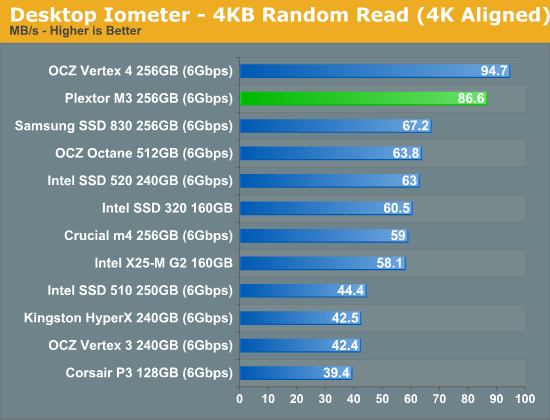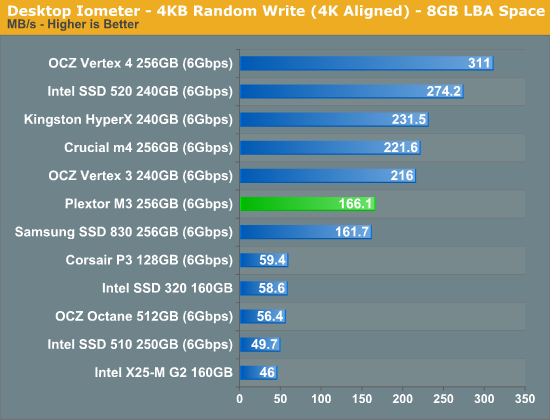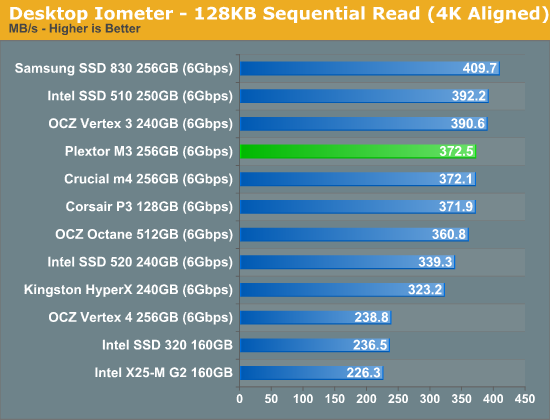The Plextor M3 (256GB) Review
by Kristian Vättö on April 5, 2012 3:05 AM ESTRandom and Sequential Read/Write Speed
The four corners of SSD performance are as follows: random read, random write, sequential read and sequential write speed. Random accesses are generally small in size, while sequential accesses tend to be larger and thus we have the four Iometer tests we use in all of our reviews. Our first test writes 4KB in a completely random pattern over an 8GB space of the drive to simulate the sort of random access that you'd see on an OS drive (even this is more stressful than a normal desktop user would see). We perform three concurrent IOs and run the test for 3 minutes. The results reported are in average MB/s over the entire time. We use both standard pseudo randomly generated data for each write as well as fully random data to show you both the maximum and minimum performance offered by SandForce based drives in these tests. The average performance of SF drives will likely be somewhere in between the two values for each drive you see in the graphs. For an understanding of why this matters, read our original SandForce article.

Plextor M3 provides very good 4KB random read performance. Looking at the Crucial m4 that uses the same Marvell controller, the Plextor M3 is 47% faster in random performance, so Plextor has clearly paid attention to their firmware.

Random write performance is not as great as random read but still quite good enough for most workloads. This time Crucial's m4 comes out 33% faster than the M3, while the SF-2281 drives are all faster as well—write less data thanks to realtime compression and data deduplication techniques and your write speeds should generally be faster.

Switching the queue depth to 32 shows the difference between SandForce and non-SandForce quite well. SandForce is in its own class but among the Marvell SSDs, the Plextor M3 is the fastest. It's important to note that only heavy I/O workloads use queue depths that reach 32; most usage models don't go over 5.
Sequential Read/Write Speed
To measure sequential performance we ran a one minute long 128KB sequential test over the entire span of the drive at a queue depth of 1. The results reported are in average MB/s over the entire test length.

Sequential read speed is identical to Crucial m4 and Corsair P3, and good if not class leading for a SATA 6Gbps SSD.

In sequential write speeds, the M3 is once again the fastest Marvell based SSD and is only a few percent behind SandForce based SSDs.










113 Comments
View All Comments
Kutark - Thursday, April 5, 2012 - link
I thought it kind of odd that the author hadn't heard of plextor until a couple of months ago. IMO basically anybody who had been building their own comps since the mid 90's should at least have heard of the brand.I wonder how old the author is. This kind of reminds me of when you mention Everquest in a conversation and the WOW generation has no clue what you're talking about.
BTW im not meaning to imply or say anything negative about the author, it just struck me as an odd thing to say.
Kutark - Thursday, April 5, 2012 - link
Well, had i read the comments i would seen that the author is 18, which explains quite a lot (again, not in a bad way)jabber - Thursday, April 5, 2012 - link
I thought the Plextor of old went bust years ago and the name was bought up by someone else?Basically standard goods with the Plextor name silkscreened on for 50% extra mark up.
I just threw out my trusty Plextor 712SA drive after about 8 years hard use.
Topweasel - Thursday, April 5, 2012 - link
No, as DVD burners became throwaway items (Sub $50) they started to offer re-branded parts, but higher quality ones. You could still tell from little things like the tray mechanism that they weren't Plextor. They also ran into a stumbling block with optics for DVD burners for the few they still manufactured. Since they are compared to the big ones, more of a boutique designer they had trouble at 16x+ of eeking out that last bit of quality. Which meant for their more expensive drives, they weren't king of the hill, meaning if reliability and not burning performance or burn quality were your concerns, then you wouldn't pay the extra amount. For the rebrands, they were actually price competitive even if they were like $5-$10 bucks more.Then came Blu-Ray drives. That did almost kill them. No one was/is buying them. Not like they would DVD drives. Internal drives also never hit the extremes that for example a DVD drive did at launch where they were $300-$400. So once again they were manufacturing expensive drives that no one was buying, and they couldn't even rebrand to make it more price competitive. That's why they went to SSD's, unlike OCZ that made the move because SSD's where much higher margin parts. Plextor did it to survive. But again they don't even have to make to many of these. Plextor makes its living as a low volume high quality high performance manufacturer. Even at their worse in 2008-2010, they were only just as good as everyone else. SSD's are just a product that they can produce that performance actually matters and higher prices are acceptable.
But no Plextor today is the same Plextor of old. Just with a new focus, but same goal.
Beenthere - Thursday, April 5, 2012 - link
Plextor has the potential to sell some decent SSDs. I think the M3 Pro should be the base model with the 3M pricing and Plextor should work on a true Pro model. The Pro pricing is unacceptable and the M3 performance lacking IMO.GrizzledYoungMan - Thursday, April 5, 2012 - link
Any reason to use 10.2 over 10.6?Kristian Vättö - Thursday, April 5, 2012 - link
From a user's standpoint, no. For reviews it's important to use the same set of software and drivers as an updated version may impact performance. In other words, we would have to test all SSDs again if we updated Intel RST to 10.6. That's why we are sticking with 10.2, at least for now.Maiyr - Thursday, April 5, 2012 - link
"Plextor as a brand is probably a new acquaintance for most people and I have to admit that I had not heard of Plextor until a couple of months ago."I must be getting old. That just seems crazy to me.
Maiyr
jwilliams4200 - Thursday, April 5, 2012 - link
With regards to idle power, the 256GB Crucial m4 shows half the idle power of the 256GB Vertex 4 in your chart, but they both have the same amount of synchronous flash.And since they are both using a Marvell controller (the V4 has a rebadged Marvell 88SS9187, the m4 has an 88SS9174), it is clear that the biggest factor in idle power consumption is NOT the amount and type of flash memory.
Kristian Vättö - Friday, April 6, 2012 - link
You really need some proof that the Indilinx Everest 2 is just a rebadged Marvell 88SS9187, I've seen nothing that indicates so.Of course the controller draws power as well and it can lead to high power consumption, so NAND is definitely not the only factor - I was only pointing out that Toggle NAND is more power efficient. It's possible that a future firmware update will decrease the power consumption of Vertex 4, that happened with Vertex 3 at least.